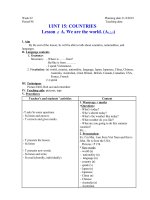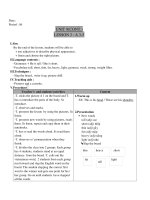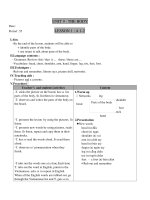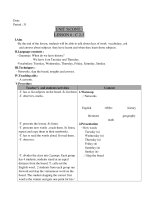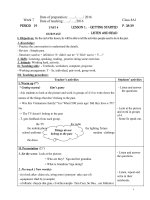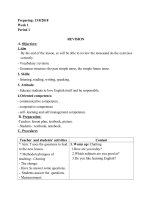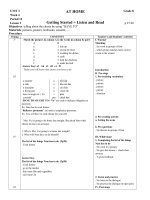unit 3 at home tiếng anh 8 sách cũ nguyễn thị thúy ngân thư viện giáo án điện tử
Bạn đang xem bản rút gọn của tài liệu. Xem và tải ngay bản đầy đủ của tài liệu tại đây (238.19 KB, 22 trang )
<span class='text_page_counter'>(1)</span><div class='page_container' data-page=1>
<i>Week: 04</i>
<i>Date of preparation: …../….. /2016</i>
<i> Date of teaching: …../….. /2016</i> <i>Class 8A1</i>
P.12 <b>Unit 3</b>
<b>AT HOME</b>
Lesson 1: - GETTING STARTED
- LISTEN AND READ
P.27,28
<b>I. Objectives:</b> By the end of the lesson, Ss will be able to understand the dialogue and use modal
verbs to talk about the housework.
<i><b>1. Knowledge:</b></i>
- Practice the conversation to understand the details.
- Review Modals / Reflexive Pronouns.
<i><b>2. Skills: Listening, speaking, reading , practice doing some exercises.</b></i>
<i><b>3. Attitude</b></i><b>: </b>Working hard, actively.
<b>II. Teaching aids: - </b>Textbook, worksheet, computer, projector.
- Working arrangement: T – Ss, individual, pair work, group work.
<b>III. Teaching procedure:</b>
<b>Teacher’s activities</b> <b>Students’ activities</b>
<b>1/ Warm up (8’) </b>
- Ask some questions to pay Ss’ attention.
<i><b>* Kim’s Game(optional) </b></i>
- T shows 6 pictures P.27. Ask Ss to look at them quickly in 30 seconds and try
to remember the verbs in the pictures as many as possible. Which team
remembering more verbs is the winner.
KEYS: wash dishes/ do the washing up , make the bed, sweep the floor, cook the
meal/ dinner, tidy up/ my room, feed the chickens.
<i><b>* Getting started</b></i>
<b>- </b>T. asks Ss look at the pictures on P.27 and tell their partner about the chores
they often do at home.
wash the dishes cook the meal
go to the market make
the bed
empty the garbage
sweep the floor tidy up feed the
chicken
- Listen and answer
the questions.
- Work in 2 teams.
- Some Ss speak out.
- Look at the pictures
on page 27, work in
pairs tell their partner
about the chores they
often do at home.
- Call some pairs
speak out.
<b>II. Presentation (22’) Listen & Read</b>
<i><b>1. Pre-teach: </b></i> T. elicits and introduces some new words
<b>New words:</b>
- a cupboard: tđ ch¹n, tđ ly (picture/ visual)
- a steamer: nåi hÊp (example)
- a saucepan: cái chảo (picture/ realia)
- a cooker: c¸i bÕp/ nåi (picture)
- (to) have to: ph¶i (translation)
- ought to + V: phải/ nên ( “ )
T. helps Ss read the new words in chorus and individually.
T.checks the vocabulary using “What & where”/ “ Rub out & remember<b>”</b>
<i><b>2. Presentation Dialouge:</b></i>
- Listen, repeat and
write in their
notebooks.
- Listen to the
teacher and answer
the questions.
<i><b>The chores you </b></i>
</div>
<span class='text_page_counter'>(2)</span><div class='page_container' data-page=2>
<i>+ Set the scene: </i>
<i><b>* Pre-questions</b></i>
1. Who are talking in the conversation?
2. Where will Nam’s mother go tonight ?
3. What will Nam have to do?
4. What ought Nam to do to cook dinner?
<b>* Read the dialogue</b>
<b>:</b>
- T. has Ss listen to the tape and follow the dialogue at the same time, and
then work in pairs to find out the answers to the pre questions ( in 2’).
` - Then T. calls some Ss to speak out their answers before the class. T.
checks with the whole class.
- T. asks Ss to listen to the dialogue again to check their pronunciation.
- T. has Ss practice reading the dialogue in pairs. (Maybe call some pairs
<i>to read out to check pronunciation/ intonation)</i>
<i>* Do exercise in Read 2:</i>
<i>- T. has Ss complete the list of the things Nam has to do individually in 2</i>
<i>minutes </i>
- T. calls some Ss to give their answers
- T. corrects with the whole class.
*Keys(Read 2): Nam has to – cook dinner/ go to the market to buy fish &
vegetables/ call his aunt, Ms Chi and ask her to meet his mother at grandma’s
house.
<i><b>3. Model sentence: ( T elicits & introduces the model sentences.)</b></i>
a. I have to go and visit grandma after work.
She has to go and visit grandma after work.
b. You ought to go to the market yourself.
He ought to go to the market himself.
<i><b>* Concept Checking: meaning, form and pronunciation.</b></i>
-What are these sentences in VN? - When do we use “have to or has
to”/ ought to?
- Can we say “he oughts to..”? No - Which verb do we use after modal
verbs? Infinitive
- Form: S + have/has to+ V - S + ought to +V
<b>Note: </b>- Has/have to + Infinitive = Must + Inf.
- “Must” diễn tả sự bắt buộc , do chủ thể
- “Have to” do yếu tố bên ngoài tác động
- “Ought to” khuyên, đề nghị làm1 việc đợc xem là đúng
<b>III. Practice (7’)</b>
<i><b>EX1: Repetition Drill using picture cues</b></i><b>.</b>
- T. has Ss use the pictures in “Getting started” b to practice. (a,b,c for <b>have/has</b>
<b>to</b> - d, e, f for <b>ought to</b>)
<b>Eg: </b>
<b>a</b>. T says “I have to feed the chickens”
<b> </b>Ss say “I have to do the washing up”
- T has Ss work in pairs in 2 min. first, then T calls some Ss to speak out.
- Guess the answer.
- Listen and read the
conversation and
find out the answers
to the pre-questions.
- Practice the
conversation in pairs
and some pairs read
aloud.
- Work individually
first, then compare
with their partners.
- Listen and answer.
- Write the model.
- Whole class.
- Work in pairs.
<b>IV. Production (6’)</b>
</div>
<span class='text_page_counter'>(3)</span><div class='page_container' data-page=3>
<i><b>EX2: Picture cue Drill</b></i>
<b>* L.F 1 </b>(P.34):Complete the dialogues, use <b>must = have/has to </b>+V
- T has Ss look at the pictures ( a-f) and use the verbs in the box and “ must- have
to” to complete the dialogues ( work in pairs).
<b>Keys: </b>1- must tidy 2- have to dust 3- must sweep
4- have to clean 5- must empty 6- must feed
<b>V. Consolidation</b>
- Ask Ss to say out again the main content of this lesson: how to use the modal
verbs.
- T asks the questions and Ss give the answers: “What do you have to do every
day/ on Sunday?”
- Listen and speak
out.
<b>VI. Homework ( 2’)</b>
- Learn and write all the words.
- Do Ex. in Workbook.
- Write the things you often have to do on Sunday.
Eg: - On Sunday morning, I have to tidy my room,...I have to help my parents do
the house work.
- On Sunday afternoon, I have to....
- On Sunday evening, I have to...
- Prepare “Speak”
</div>
<span class='text_page_counter'>(4)</span><div class='page_container' data-page=4>
<i>Week: 05</i>
<i>Date of preparation: …../….. /2016</i>
<i> Date of teaching: …../….. /2016</i> <i>Class 8A1</i>
P.13 <b>Unit 3</b>
<b>AT HOME</b>
Lesson 2: Speak
+ Describe your room
P.28, 29
<b>I. Objectives:: </b>By the end of the speaking skill lesson, Ss will be able to use the prepositions of
place to talk about the positions of furniture in the kitchen and in the living-room.
<i><b>1. Knowledge:</b></i>
- Vocabulary: Some furniture vocabulary.
- Revision: Prepositions of place to talk about the positions of the furniture in the kitchen and in the
living-room.
<i><b>2. Skills: Speaking.</b></i>
<i><b>3. Attitude</b></i><b>: </b>Working hard, actively.
<b>II. Teaching aids: - </b>Textbook, computer, projector.
- Working arrangement: T – Ss, individual, pair work, group work.
<b>III. Teaching procedure:</b>
<b>Teacher’s activities</b> <b>Students’ activities</b>
<b>I/ Warm up (10’)</b>
<i><b>1. Revision: a/ Picture cue Drill</b></i>
<b>* L.F 1 </b>(P.34):Complete the dialogues, use <b>must = have/has to </b>+V
- T has Ss look at the pictures (a-f) and use the verbs in the box and “
must- have to” to complete the dialogues ( work in pairs).
<b>Keys: </b>1- must tidy 2- have to dust 3- must sweep
4- have to clean 5- must empty 6- must feed
<b>* L.F 2 </b>(P.35):
- T explains how to do L. focus 2: T. has Ss look at the pictures, use “ought to”
to give advice to the people in the pictures.
- T has do the exercise in pairs first , then T. calls some Ss to speak out before
the class.
<b>Keys:</b> b- You ought to get up earlier.
c- You ought to eat more fruit and vegetables/ ...eat less sugar and fatty
food.
d- You ought to go to the dentist’s.
<b>2. Network:</b>
<b>Write down the things in the kitchen and the prepositions of place</b>
- Work in pairs.
- Work in pairs.
- Some Ss speak out.
- Ss play game.
Things in
</div>
<span class='text_page_counter'>(5)</span><div class='page_container' data-page=5>
<i><b> The things in the kitchen</b></i> <i><b>The prepositions of place</b></i>
Rice cooker. at, on, in, under, above, next to,
Refrigerator. between…and…, opposite, near, in front of,
dish rack. behind, beside, in the middle, on the right, on the left…
stove.
sink.
table and chairs.
cupboard.
…
- T has Ss work in groups of 4 to write as many words as possible in 2’.
- Then give feed back by hanging their posters on the board.
- T. corrects and asks Ss to read out the words and phrases they found.
<i><b>II. Pre-speaking (12’)</b></i>
<i><b>1. Pre-teach:</b></i> T. uses some pictures, elicits and introduces some new
vocabulary.
<i><b>New words:</b></i>
- a rug: tấm thảm (realia/ picture)
- a dish rack: chạn, giá đĩa bát (picture)
- a calendar: lịch (realia)
- a folder: b×a cøng kĐp giÊy tê (realia)
- a counter: tủ đồ bếp, quầy hàng(picture)
a wardrobe: tủ quần áo (visual)
- a knife- knives: con dao (realia)
- a cushion: đệm (visual)
- T. lets Ss read the new words in chorus and individually.
* Checking -Rub out & Remember/ Matching (using pictures)
<i><b>2. Revision: </b></i><b>Making suggestions:</b>
<i><b>- Let’ ....</b></i>
<i><b>- We ought to...</b></i>
<i><b>- We should....</b></i>
- Work in groups of
4.
- Ss hang their
posters on the board
and correct.
- Ss read out the
words and phrases.
- Listen, repeat and
write in their
notebooks.
- Listen and speak
out.
<b>III. While- speaking ( 15’)</b>
<i><b>1. Speak 1 (page 28): </b></i>
- Ss look at the pictures on P.28 and talk about the positions of each item (pair
work).
+ T has Ss speak out the things in the pictures first
+ T. elicits and does first as an example:
<b>Eg: </b>S1: Where is the fruit?
S2: The fruit/ It is in the bowl.
- Look at the pictures
on P.28
- Work in pairs talk
about the positions of
each item.
</div>
<span class='text_page_counter'>(6)</span><div class='page_container' data-page=6>
- T. asks Ss practice in pairs in 2’.
Keys: - The table is in the middle of the kitchen.
- The calendar is on the wall (under the clock and above the fridge)
- The sink is next to the stove.
- The cupboard is on the wall, above counter.
- The knives are on the wall, under the cupboard.
- The bowl of fruit is between the rice cooker and the dish rack.
- The clock is on the wall.
- The flowers are on the table.
<i><b>2. Speak 2( page 29):</b></i>
<i><b>- T. sets the scene: Mrs Vui bought new furniture for her living room, but she </b></i>
<i>can’t decide where to put it. You should help her to arrange the furniture. </i>
- Then T. has Ss look at the picture and speak out the things they see in the
picture
- Next, T. elicits and does first as an example:
Eg: T: Let’s put the magazines on the shelf above the books.
S1: OK. And I think we ought to put …
T: No. We should put ………..
- Then T. asks Ss to work in pairs or groups of four of 4 to arrange the furniture
in Mrs Vui’s living room.
- Ask Ss to practice speaking in 4 min.
Note: If they agree, they may use: OK/ You are right.
If they disagree, they may use: No, I think we’d better/ ought to put../ I
think it should be...
* + Let’s put the shelf at one of the corner, opposite the couch.
+ Let’s put the telephone next to the couch.
+ Let’s put the clock on the wall between the picture and the shelf.
- After that, T calls some Ss to speak out before the class.
- T. corrects with the whole class.
<b>Eg: </b>S1: Let’s put the magazines on the shelf above the books.
S2: OK. And I think we ought to put the coffee table between the couch
and the armchair.
S1: You’re right. And let’s put the TV next to the coffee table.
S2: No. We should put the TV on the shelf.
A: Let’s put the coffee table between the couch and the armchair.
B: OK. I think we ought to put the rug on the floor under the coffee table.
A: How about the shelf? Let’s put it at one of the corners, opposite the
couch.
B: All right. And I think we ought to put the magazines and telephone on
the shelf.
A: OK. Let’s hang the clock next to/ above the picture. How about the
TV?
B: I think we should put TV on the small table next to the shelf.
- Listen to the
teacher.
</div>
<span class='text_page_counter'>(7)</span><div class='page_container' data-page=7>
A: And about the lamp? Let’s put it in the corner next to the couch.
B: OK.
<b>IV. Post- Speaking (7’)</b>
- T. has Ss talk about a description of the room where they have just arranged the
furniture. ( in pairs)
Eg: In Mrs Vui’s living room, there is ....on... .The drug is in the middle of the
room, under the table....
- Then T. calls some Ss to speak out.
- T calls some Ss to speak out .
- T. corrects mistakes if necessary.
<b>V. Homework (1’) </b>
- Learn by heart the new words.
- Do Speak 2 + Write a description of the room where you’ve just arranged the
furniture.
- Describe your living room/ bedroom.
- Prepare for the next lesson - Listen.
- Pair work.
- Listen and take
notes.
<i>Week: 05</i>
<i>Date of preparation: …../….. /2016</i>
<i> Date of teaching: …../….. /2016</i> <i>Class 8A1</i>
P.14 <b>Unit 3</b>
<b>AT HOME</b>
Lesson 3: listen + READ P.27,28
</div>
<span class='text_page_counter'>(8)</span><div class='page_container' data-page=8>
- Listen a conversation to understand how to make the special Chinese fried rice and the
items Mrs.Thu and Lan used to cook the “Special Chinese Fried Rice”.
- Read the paragraph to understand the safety precautions in the house and use “Why &
Because”
<i><b>1. Knowledge:</b></i>
- Vocabulary: a precaution, a socket, a match, an object, safety, to destroy, to injure sbd, a pair of
<i>scissors, a bead.</i>
- Listen to a conversation to understand how to make the special Chinese fried rice.
- The items Mrs.Thu and Lan used to cook the “Special Chinese Fried Rice”.
- Put the steps to make the “Special Chinese Fried Rice”.
- Reading for the details about safety precautions.
- Practicing asking with “Why” and answer with “Because”.
<i><b>2. Skills: Listening – speaking - reading.</b></i>
<i><b>3. Attitude</b></i><b>: </b>Working hard, actively.
<b>II. Teaching aids: - </b>Textbook, computer, projector.
- Working arrangement: T – Ss, individual, pair work, group work.
<b>III. Teaching procedure:</b>
<b>Teacher’s activities</b> <b>Students’ activities</b>
<b>I. Warm up (2’)</b>
<b>*Hangman</b>
- T. helps Ss revise some words about things in
the kitchen by using “hangman”.
- - - - - - FRIED RICE
- Ss play game.
<b>II. Pre- listening (7’)</b>
- T. has Ss look at picture on page 30 and give
the names of the food or the cookers
<i><b>Ex1: Write the names of the food or the</b></i>
<i><b>cookers in pictures – P.30</b></i>
a. rice / noodles
b. sauce pan / frying pan
c. garlic, onions / garlic, green pepper
d. chicken, peas / ham, peas.
- T. lets Ss write down in their notebooks in 2
minutes.
- T. sets the scene: “you are going to listen to the
conversation between Mrs.Thu and Lan about
the necessary ingredients to cook the “Special Chinese
Fried Rice”.
- T. has Ss guess what items Lan and Mrs.Thu
used to cook the “S.C.F.R”
<i><b>Ex2: Guessing what items Lan and Mrs.Thu</b></i>
<i><b>used to cook the “S.C.F.R”</b></i>
Guess Correct
A Fried rice
B Pan
C Garlic and green peppers
D Ham and peas
- Ss look at the picture and write down names of
the food or the cookers.
- Ss listen the guide
</div>
<span class='text_page_counter'>(9)</span><div class='page_container' data-page=9>
- T. has Ss guess and give their feed back in 1
minute.
<b>III. While-listening (8’)</b>
- T. has Ss listen to the conversation to the tape
and check their prediction twice.
- T. has Ss share with their partners, compare
and give their answers
- Then T. has Ss listen again to correct if
necessary.
<i><b>Ex3: Ordering the steps to cook the “Special</b></i>
<i><b>Chinese fried rice”</b></i>
a. heat the pan
b. put the ham and peas in
c. use the big pan
d. fry the garlic and green peppers
e. put the rice and a teaspoon of salt in
f. put a little oil in it
- Firstly, T. has Ss read all steps and do it
individually.
- Next, T. has Ss listen to the tape again to put
the steps into the correct order.
- T. has Ss give the feed back.
<i><b>Answerkey:</b></i>
1. c 2. f 3. a 4. d 5. b 6.e
- Ss listen to the conversation to the tape and
check the guess.
- Ss share with their partners and give the
answers.
- Ss listen again to put the steps to make the
special Chinese fried rice.
- Ss read all steps, do it individually, then listen
to the tape and correct and give the answers.
<b>IV. Pre - reading</b> (12’)
- T. introduces the topic of the passage reading
and some new
words to Ss.
<b>*New words:</b>
<i>- a precaution: sự đề phòng, sự phòng</i>
<i>ngừa</i>
<i>- a socket (realia): ổ cắm điện </i>
<i>- a match (realia): diêm</i>
<i>- an object: vật , đồ vật </i>
<i>- safety (n): sự an toàn </i>
<i>- to destroy: phá hủy </i>
<i>- to injure sbd: làm bị thương ai </i>
<i>- a pair of scissors: cái kéo</i>
<i>- a bead: vật tròn nhỏ</i>
- T. helps Ss read vocab inn chorus and
individually.
- Then, T. checks vocab using technique “ Slap
the board”
Read 1 – P. 31
<i><b>Ex2:True / false statements predictions </b></i>
- T. has Ss read the statements and guess
which is true , which is false .
<b>Statements</b> <b>Guess</b>
1. It is safe to leave medicine around the
house.
- Ss listen, repeat read out and write vocab.
- Ss read vocab.
</div>
<span class='text_page_counter'>(10)</span><div class='page_container' data-page=10>
2. Drugs can look like candy.
3. A kitchen is a suitable place to play.
4. Playing with one match cannot start a
fife.
5. Putting a knife into an electrical socket is
dangerous.
6. Young children do not understand that
many house hold objects are dangerous.
- T. calls on Ss give their predictions and write
them on the board.
<b>III. While – reading (10’)</b>
<b>a. Reading text:</b>
- T. has Ss read the poster in silence and check
their predictions in 4 minutes, then correct false
sentences.
- T. has Ss give the correct answers and correct
again if necessary.
<i><b>Answer key:</b></i>
1. It is safe to keep medicine in locked cupboards
.
3. A kitchen is dangerous place to play .
4. Playing with one match can cause fire.
<b>b. Ex3: Comprehension questions: Read 2 – P.</b>
<b>32</b>
- T. asks Ss to work in pairs to find out the
answers of these questions.
- T. calls on some pairs to practice asking and
answering the questions .
- T. has Ss give feedback
<i><b>Answer key:</b></i>
a. Because children often try to eat and drink
them
b. Because the kitchen is a dangerous place to
place
c. Because playing with one match can cause
fire.
d. Because children often try to put something
into electrical sockets and electricity can kill.
e. Because the dangerous objects can injure or
kill children
- T. has Ss listen to the tape to check
pronunciation and read out again.
- Ss read text and correct Ex2.
- Ss correct the fale sentences.
- Ss read the text again to answer the questions
- Ss listen to the tap to check pronunciation and
read out again.
<b>IV. Post - reading (5’)</b>
<b>*Discussion </b>
- T. asks Ss to work in groups , discussing about
the topic.
1. Safety precautions in the street.
2. Safety precautions at school.
- Ss discuss about the topic in groups.
<b>V. Homework (1’) </b>
</div>
<span class='text_page_counter'>(11)</span><div class='page_container' data-page=11>
- Redo again all exercises.
- Do Read 2 – P. 32 and the exercises in
workbook.
- Prepare “Write”
<b>* TAPE TRANSCRIPT</b>
Lan: Can I help you to cook dinner, Mom?
Mrs Tu: Sure. You can cook the “Special Chinese fried Rice” for me. Use the big pan, please.
Lan: Okay. How much oil do I put in?
Mrs Tu: Just a little. Wait until it’s hot and then fry the garlic and the green peppers.
Lan: Do I put the ham and the peas in now?
Mrs Tu: Yes. And you can put the rice and a teaspoon of salt in.
Lan: Yummy! It smells delicious
<i>Week: 05</i>
<i>Date of preparation: …../….. /2016</i>
<i> Date of teaching: …../….. /2016</i> <i>Class 8A1</i>
P.15 <b><sub>Unit 3</sub></b>
<b>AT HOME</b>
Lesson 4: <b>WRITE</b> P.32,33
<b>I. Objectives:</b> By the end of the writing lesson, Ss will be able to write a description of a room in
their house.
<i><b>1. Knowledge:</b></i>
- Grammar : The simple present tense.
- Prepositions of place.
- Writing a description of a room.
<i><b>2. Skills: Writing.</b></i>
<i><b>3. Attitude</b></i><b>: </b>Working hard, actively.
<b>II. Teaching aids: - </b>Textbook, computer, projector, worksheets.
- Working arrangement: T – Ss, individual, pair work, group work.
<b>III. Teaching procedure:</b>
<b>Teacher’s activities</b> <b>Students’ activities</b>
<b>I. Warm up (7’)</b>
- T asks some questions to pay Ss’ attention.
<i><b>1. Revision</b></i><b>: Pelmanism - Prepositions of place</b>
<i>Left</i> <i>above</i> <i>on</i> <i>Right</i>
<i>below</i> <i>under </i> <i>In front of</i> <i>In</i>
<i>Behind</i> <i>out</i>
<b>Or “Word- square”(</b>poster/ extra board<b>)</b> <b>- Prepositions of place</b>
-> Opposite, under, to, next to
<- Behind, near, in
From, on, in
<b>- </b>Whole class.
- Work in 2 groups.
- Some Ss speak out.
<b>F</b> <b>D N I</b> <b>H E B O</b>
<b>R</b> <b>A E N E X T O</b>
<b>O P P O S</b> <b>I</b> <b>T E</b>
</div>
<span class='text_page_counter'>(12)</span><div class='page_container' data-page=12>
Up, to to
- T. has Ss find out the prepositions of place in the Word square in 3’.
- Then T calls some Ss to write on the board.
- T. corrects with the whole class.
<i><b>2. Chatting: Ask Ss something about the room on P.32</b></i>
<b>-</b> Which room is it?
<b>-</b> What is this? Where is it?
- Answer the
teacher’s questions.
<b>II. Pre-writing ( 15’)</b>
<i><b>1. Pre- teach: New words:</b></i>
- a sink: bồn, chậu rửa bát đĩa (visual)
- a towel rack: giá để khăn(visual)
- a lighting fixture: đèn chùm (visual)
- beneath: phía dới(translation)
- folder: kẹp đựng hồ sơ(realia/ visual)
T. helps Ss read the new words in chorus and individually.
<i><b>T. Checks vocab by using “Rub out and remember”</b></i><b> (optional): </b>To
help Ss memorize the new words.
- Rub out the new words one at a time.
- Each time, rub out an English word, then point to Vietnamese translation and
ask “What’s this in English?”. - - When all the new words are rubbed out, go
through the Vietnamese list and get Ss to call the English words. - Ask Ss to
come to the board and write the English words again.
<i><b>2. Reading the description of Hoa’s room.</b></i>
- T. asks Ss to read the description of Hoa’s room individually in 2’, then asks Ss
to work in pairs to answer some comprehension questions:
<b>*Comprehension questions:</b>
a. What is there on the left of the room? (There is a desk)
b. What are there on the desk? (Many folders)/ What’s near the desk? (a
bed)
c. Where is the bookshelf? (It is above the desk)
d. What is there on the right side of the room? (There is a window)
e. Where is the wardrobe? (It is beside the window and opposite the
desk)
- T. calls some Ss to speak out before the class. T. corrects.
- Listen, repeat and
write the new words.
- Practice reading in
chorus and
individually.
- Read the
description of Hoa’s
room individually,
then asks Ss to work
in pairs to answer
some comprehension
questions.
</div>
<span class='text_page_counter'>(13)</span><div class='page_container' data-page=13>
<i><b>III. While- writing ( 12’)</b></i>
<i><b>3. Write 2: Write the description of Hoa’s kitchen</b></i>
- T. asks Ss to work in group of 4 (or in pairs) to help one another describe Hoa’s
room., using the picture and cues on P. 33 in 3’ (orally only ).
- Then T. calls some Ss to speak out before the class.
- After that T has Ss write a description of Hoa’s kitchen individually in 5 min.
<i>* Answer Keys: </i>
This is Hoa’s kitchen. There is a refrigerator in the right corner of the
room. Next to the refrigerator is a stove and an oven. On the other side of the
oven, there is a sink and next to the sink is a towel rack. The disk rack is (stands)
on the counter, to the right of the window and beneath the shelves. On the
shelves and on the counter beneath the window, there are jars of sugar, flour and
tea. In the middle of the kitchen, there is a table and four chairs. The lighting
fixture is above the table, and beneath the lighting fixture is a vase with flowers.
<b>- </b>Work in group of 4
(or in pairs).
- Some Ss speak out.
- Write a description
of Hoa’s kitchen
individually.
<b>IV. Post-Writing (10’) </b>
<i><b>1. Correction</b></i>
- T. has Ss swap their writing with their partner and pair compare.
- T asks 2 Ss to hang their description on the board.
- T elicits the corrections from Ss if there are mistakes in their writings.
<i><b>2. Exhibition</b></i>
- T asks Ss to work in groups of 4 and write a description of a room in your
house on the posters. Then asks them to show their wring.
- T calls some groups to hang their writing on the board. T gives remarks and
checks with the whole class.
<i>* Suggested answer:</i>
My room is on the second floor. It is a quite big room and very light,
because there are two windows overlooking the garden. My desk is between the
window and my bed is against the wall opposite the desk. there is an armchair
near the desk and behind the armchair there is a wardrobe. Opposite them, there
is chest of drawers with bookshelves next to it . I’m very pleased with my room.
<i><b> 3. Free back: Describe your classroom “This is my classroom…..”.</b></i>
- Work in pairs.
- 2 Ss hang their
writing on the board.
- Correct.
- Work in groups of
4.
- 2 groups hang their
writing on the board.
<b>V. Homework (2’)</b>
- Learn and write all the words. Do Write 1,2 again.
- Write the description of a room in your house.
- Prepare lesson 6: Language focus3,4.
- Do Ex in Workbook.
</div>
<span class='text_page_counter'>(14)</span><div class='page_container' data-page=14>
<i> Week:06</i>
<i>Date of preparation: 17/ 9 /2016</i>
<i> Date of teaching:24/9 /2016</i> <i>Class 8A1</i>
<b>Period 16</b> <b> Unit 3 </b>
<b>At home</b>
<b> Lesson 6: - Language focus 3,4 </b> <b>P. 34- 37</b>
<b>I. Objectives:</b> By the end of the lesson, Ss will be able to further practice in Reflexive Pronouns and
“Why questions with Because answers”
<i><b>1. Knowledge:</b></i>
- Reflexive Pronouns : Myself/ ourselves/ yourself - yourselves/ himself/ herself/ themselves/ itself
- Why...? Because...
<i><b>2. Skills: Practice doing exercises.</b></i>
<i><b>3. Attitude</b></i><b>: </b>Working hard, actively.
<b>II. Teaching aids: - </b>Textbook, computer, projector, worksheets.
- Working arrangement: T – Ss, individual, pair work, group work.
<b>III. Teaching procedure:</b>
<b>Teacher’s activities</b> <b>Students’ activities</b>
<b>I. Warm up (8’)</b>
- T asks some questions to pay their attention.
- Ss answer.
<i><b>* Revision: Language focus 2 (P35)</b></i>
<b>-</b> T. asks to look at the pictures and find the reason of the results.
<b>-</b> T. has Ss give the advice to these people using “ought to”
<b>-</b> Ask Ss to work in pairs.
<b>-</b> T calls some Ss to speak out before the class. T. corrects with the whole
class.
* Keys: b. You ought to get up early
c. You ought not to eat too much/ You ought to eat mare fruits
and vegetables.
- Answer the
teacher’s questions.
<b>- </b>Whole class.
</div>
<span class='text_page_counter'>(15)</span><div class='page_container' data-page=15>
d. You ought to go to the dentist’s to check your teeth
<b>II. Practice (36’): </b>
<b>1. Language focus 3: Reflexive pronouns: (16’)</b>
<i><b>a. Pelmanism</b></i>
I you we He she they It
myself himself itself yourself ourselves themselves Herself
b. Substitution Drill
Teacher says:
I -> I
He -> He
You ->You
She -> She
We -> we
They -> They
Students say:
did it myself
himself
yourself
herself
ourselves
themselves
Eg: I cut myself.
She looked at herself in the mirror.
<i><b>* Concept check: Đại từ phản thân diễn tả một hành động quay trở lại với </b></i>
<i><b>chính chủ ngữ thực hiện hành động đó.</b></i>
<i><b>c. Chain game</b></i>
Cues: - make the bed / feed the animals / do home work / wash the bike...
- Work in groups of 4 and say:
S1: I made the bed myself
S2: S1 made the himself / herself and I fed the animals myself
S3: S1...himself / herself and S2 fed...himself/ herself and I did
homework myself.
S4: ...
<b>d. Ex1: Language focus 3 (P.36)</b>
<b>-</b> T. lets students complete the dialogue in pairs in 3’.
<b>-</b> T. calls some pairs to speak out before the class.
<b>-</b> T. corrects with the whole class.
- Listen to the
teacher carefully.
- Play the game.
- Whole class.
- Answer the
teacher’s questions.
- Work in groups of
4
<b>- </b>Work in pairs.
<i><b>2. Language focus 4 – Why – because</b></i>
<i><b>a. Revision: </b></i>
<i><b>Why….? – Because…</b></i>
Eg:
<i><b>b. Ex3:</b><b> Language focus 4 (P36)</b></i>
<b>-</b> Ss look at the pictures on P.36-37
<b>-</b> Ss work in pairs to ask and answer the question about Hoa, Nam, Ha, Nga
using Why- Because.
<b>-</b> T elicits the pictures from Ss :
Pic b- Who’s this?/ What’s he doing?
Pic c- Who’s this?/ Where is she going?
- Answer the
teacher’s questions.
</div>
<span class='text_page_counter'>(16)</span><div class='page_container' data-page=16>
Pic d- Who’s this?/ What’s she doing?/ Does she get a good mark?
Pic e- Who’s this?/ What’s she doing?/ What does she hold in her hand?/
Did she go to the movies?
- T. has Ss work pairs in 3’. Then T. calls some pairs to speak out before the
class.
- T. corrects with the whole class.
<i>* Possible answers: </i>
b/ Why did Nam have to cook dinner? Because his mother was home late.
c/ Why did Mrs.Vui come home late? Because she visited her grandma
d/ Why did Ha fail her English exam/ a bad mark of English? Because she
played video games so much and she didn’t learn for exam.
e/ Why didn’t Nga go to the movie? Because she had to do her chores. she had
to clean the kitchen and sweep the living room.
<b>- </b>Some Ss speak out.
<b>V. More exercises (10’):</b>
- Explain how to do each exercise.
- Have Ss do each individually first, then compare with their partners.
- Call some Ss to check.
<b>Ex.I. Fill in each blank with a correct reflexive pronoun:</b>
1. My sister often looks at………in the mirror.
2. Peter made …………..a sandwich.
3. hoa and I ……….saw that accident yesterday.
4. Did you pay for ……….?
5. The children can look after ……….for a few days.
6. Please help me. I can’t do it………
7. Take care of ………., children.
8. The computer will turn off ………..if you don’t use it.
<b> Ex.II. Complete the dialogue</b>:
a. Did someone help Ba to draw that picture? -> No. He did it _______.
b. The repair man can’t fix the washing machine until tomorrow.
-> Come on. We’ll have to try and do it _____.
c. “What’s the matter, Hoa?” -> “I cut_______.”- “Let me see. Oh it’s all right. You
didn’t cut ______ badly.”
d. Why are you crying, Nga?-> I’ve just watched the movies Romeo and Juliet. The
boy killed _____ and then the girl killed _____ as well.
-> Why did they kill _______ ? -> It’s along story.
e. Boys and girls, you’ll do the experiment this afternoon.
-> Will you come to help us?
Yes. I’ll. But you’ll have to do it _______ first.
<b>Ex.III. Word cue drill:</b>
Eg: a. You/ do / homework. Did you do your homework? - Yes. I did it myself.
b. He / fix / washing machine
c. Mary / cook / dinner
d. These students/ paint/ the pictures
e. You / do / your chores
<b>- </b>Work individually
first, then compare
with their partners.
<b>- </b>Some Ss speak out
or write on the board.
<b>VI. Homework (1’) </b>
- Learn and write all the words.
- Do all exercises in Workbook.
</div>
<span class='text_page_counter'>(17)</span><div class='page_container' data-page=17>
- Review for Test 1.
<i> Week:06</i>
<i>Date of </i>
<i>preparation: 17/ 9</i>
<i>/2016</i>
<i> Date of </i>
<i>teaching:24/9 /</i>
<i>2016</i>
<i>Class 8A1</i>
<b>Period 17</b> <b> REVISION </b>
<b>FOR TEST 1 </b>
<b>I. Objectives:</b> By the end of the lesson, Ss will be able to review the vocabulary & grammar from
Unit 1 to Unit 3. Practice in doing the exercises and correcting the mistakes.
<b>* Teaching aids: </b>board, worksheet (poster/ extra board).
By the end of the lesson, Ss will be able to further practice in Reflexive Pronouns and “Why
questions with Because answers”
<i><b>1. Knowledge:</b></i>
- Review the vocabulary & grammar from Unit 1 to Unit 3.
- Practice in doing the exercises and correcting the mistakes.
<i><b>2. Skills: Practice doing exercises.</b></i>
<i><b>3. Attitude</b></i><b>: </b>Working hard, actively.
<b>II. Teaching aids: </b>worksheets.
- Working arrangement: T – Ss, individual, pair work, group work.
<b>III. Teaching procedure:</b>
<b>Teacher’s activities</b> <b>Students’ activities</b>
<b>I. Warm up (5’)</b>
- T asks some questions to pay their attention.
- Ss answer.
<b>* Chatting: </b>
- Answer the
teacher’s questions.
<b>- </b>Whole class.
<b>II. Revision (10’):</b>
- Get Ss to review the some structure, grammar and vocabulary they have learnt.
- Elicit and get some Ss to speak out.
- Get Ss to give their examples.
</div>
<span class='text_page_counter'>(18)</span><div class='page_container' data-page=18>
- Teacher writes on the board.
<i><b>1. Vocabulary: </b></i>
- Prepositions of place.
- Adverbs of place.
- Things in the kitchen; living room
- Reflexive pronouns.
<i><b>2. Grammar: </b></i>
- Adj. + Enough to infinitive
- Ought to / have to/ must + V
- Why / Because
- Simple present( Past) tense/ Simple future tense/ near future.
teacher’s questions.
<b>- </b>Give their own
examples.
- Write in their
notebooks.
<b>III. Practice</b> (30’) (Do exercises + correct)
- T. gives Ss worksheets. There are 6 exercises:
- T. explains how to do each exercise first.
- Then lets Ss do each exercise individually or in pairs in some minutes.
- After that T. calls some Ss to write on the board or speak out before the class.
- T. corrects with the whole class.
<b>Ex.I./ Pick out one word that has different sound from the others</b>
<b>Answer key:</b>
1. B. sink
2. A. deaf
3. C. ought
4. B. fry
5. D. children
<b>ExII./ Choose the best answer to complete the following sentences.</b>
<b>Answer key:</b>
1. received
2. pretty new red
3. on
4. themselves
5. to buy
6. next
7. Why
8. have to
<b>9.</b> to play
<b>Ex.III./ Put the correct forms of the verbs.</b>
<b>Answer key:</b>
<b>- </b>Work individually
first, then compare
with their partners.
<b>- </b>Some Ss speak out
<b>- </b>Correct.
<b>- </b>Work individually
first, then compare
with their partners.
<b>- </b>Some Ss speak out
or write on the board.
- Correct.
</div>
<span class='text_page_counter'>(19)</span><div class='page_container' data-page=19>
1. lived
2. did
3. doesn’t like – had
4. to come
5. does… do – watches – is reading
<b>ExIV./ Read the passage, then answer the questions below:</b>
<b>Answer key:</b>
<b>1.</b> My aunt is an actress.
<b>2.</b> She must be at least thirty – five years old.
<b>3.</b> No, she doesn’t.
<b>4.</b> Yes, she will.
<b>5.</b> he had to wear short socks and a bright orange – colored dress.
<b>ExV./ Write a paragraph about Ba, using the information below.</b>
Nam : Nguyen Van Ba
Age : 14
Character : Sociable, generous, kind
Appearance : Tall, thin, short curly hair
Address : 45 Tran Hung Dao Street, Hanoi.
Family : Mother, father, a younger sister.
Hobbies : reading. playing football.
Friends : Nam, Minh, Ha.
<b>Ex.VI./ Choose the underlined word or phrase that needs correcting</b>
<b>Answer key:</b>
1. D. to use
2. B put
3. don’t have
4. B to travel
5. B to go
the board.
- Correct.
<b>- </b>Work in pairs
<b>- </b>Some Ss speak out
or write on the board.
- Correct.
<b>-</b> Pair work
<b>- </b>Work individually
first, then compare
with their partners.
<b>- </b>Some Ss speak out
or write on the board.
- Correct.
<b>IV. Homework (2’) </b>
- Do exercises again.
- Revise all the vocabulary and grammar structures from Unit 1-3 .
- Prepare for Test 1.
</div>
<span class='text_page_counter'>(20)</span><div class='page_container' data-page=20>
<b>Grade 8</b>
<b>Revision for test (N</b>
<b>0</b><b><sub>1): More exercises</sub></b>
<b>I./ Pick out one word that has different sound from the others</b>
1. A. knife
B. sink
C. excite
D. device
2. A. deaf
B. bead
C. lead
D. Teach
3. A. house
B. couch
C. ought
D. counter
4. A. candy
B. fry
C. many
D. happy
5. A. character
B. Christmas
C. school
D. children
<b>II./ Choose the best answer to complete the following sentences.</b>
1. I (sent/ gave/ received / took) a letter from my old friend last week.
2. She
’<sub>s wearing a (red new pretty/ new pretty red/ pretty red new/ pretty new red) </sub>
dress.
3. My brother was born (in/ at/ on / during) June 12
th<sub> 1986.</sub>
4. The children are old enough to look after (them/ themselves/ their/ themself).
5. Lan is going (buy/ buying/ bought/ to buy) a new bike.
6. There is an oven (beside/ next/ right/ left) to the refrigerator.
7. (What/ How/ Why/ When) were you late for class?
-
Because I got up late.
8. I ( ought to/ must/ should/ have to) work every day from 8.30 to 5.30.
9. It
’<sub>s dangerous to let children (play/ to play/ playing/ to playing) with matches.</sub>
<b>III./</b>
<b> Put the correct forms of the verbs.</b>
1. Last year we (live) in Nha Trang with our grand parents.
2. Do you like swimming Ba? I (do) when I was a child.
</div>
<span class='text_page_counter'>(21)</span><div class='page_container' data-page=21>
5. What Mai usually (do) after dinner? She usually (watch) TV but now she (read)
newspapers.
<b>IV./ Read the passage, then answer the questions below:</b>
My aunt is an actress. She must be at least thirty – five years old. In spite of
this she often appears on the stage as a young girl She will have to take part in a new
play soon. This time, she will be a girl of seventeen. In the play, she must appear in a
bright red dress and long black stockings. Last year, in another play, she had to wear
short socks and a bright orange – colored dress. If anyone ever asks her how old she
is, she always answers, “My dear, it must be terrible to be grown up”.
<i><b>Questions:</b></i>
1. What does your aunt do?
2. How old is she?
3. Does she often appear on the stage as an old lady?
4. Will she act the part of the girl of seventeen in a new play soon?
5. What did she have to wear in another play last year?
<b>V./ Write a paragraph about Ba, using the information below.</b>
Nam : Nguyen Van Ba
Age : 14
Character : Sociable, generous, kind
Appearance : Tall, thin, short curly hair
Address : 45 Tran Hung Dao Street, Hanoi.
Family : Mother, father, a younger sister.
Hobbies : reading. playing football.
Friends : Nam, Minh, Ha.
<b>VI./ Choose the underlined word or phrase that needs correcting</b>
1. This software isn
’<sub>t good enough for children use</sub>
A
B C D
2. Let
<sub> s putting the armchair opposite the couch in the living room.</sub>
’A B C D
3. I can stay in bed tomorrow morning because I haven
’<sub> t to go to work.</sub>
</div>
<span class='text_page_counter'>(22)</span><div class='page_container' data-page=22></div>
<!--links-->
